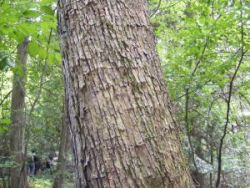Toronto Media Co-op
Local Independent News
Wind-thrown Ironwoods: tales of a splintered land
from Knowing the Land is Resistance
http://knowingtheland.wordpress.com
The forest at Iroquois Heights in Hamilton, Ontario has a unique composition and a strong diversity of plants, mammals, and birds. Forest fragmentation is a cause of this uniqueness but also makes the forest vulnerable. What can understanding the history and health of this land tell us about its possible futures, and about the future of those of us who live around it?
Traffic passes by below us in an endless, noisy, polluting stream. Where the Bruce trail runs through Hamilton, it is squeezing through the most urbanized stretch of the Niagara Escarpment ecosystem. Inevitably, the trail here includes crossing massive city infrastructure, like the section of trail that is the 403 pedestrian overpass.
We’re on our way to explore Iroquoia Heights, a patch of forest and field on the edge of the escarpment in Ancaster. It’s been in the news a fair bit over the last year or so, because of its unhealthily large deer population. The forest there is no longer connected to any other suitable deer habitat, and the Meadowlands development encroaches from the south, so the deer can’t disperse. To animals, it is an endless, impassible barrier, keeping Iroquoia Heights to the East cut off from the much larger forests to the West.
Once across the bridge, we’ve entered Iroquoia Heights. We catch the Bruce Trail heading North-East into some scrubby lands, old fields that have re-wilded into tangled groves of Hawthorn and Dogwood. These shrub lands are ideal songbird habitat. As we walk the narrow path, we move through circles of the sharp ‘chip-chip’ alarm sound of cardinals. To encourage birds here further, folks have attached birdfeeders into many trees along the trail.
The trail descends slightly and the shrubs thin out, leaving us in a flat, low meadow. Now that the ground is clear, we can see that this land lacks the characteristic hills and bowls that form in an old forest as trees uproot and logs slowly decompose. The flatness of this land means that it was likely graded and ploughed after the original forest was cut. A hawk circles slowly above, and we get down into the grasses to excitedly watch a tiny black shrew squirm between Goldenrod roots.
About the poster
The site for the Toronto local of The Media Co-op has been archived and will no longer be updated. Please visit the main Media Co-op website to learn more about the organization.
